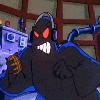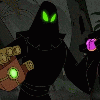
Phantom Blot
CBUB Wins: 0
CBUB Losses: 1
CBUB Ties: 0
Win Percentage: 0%
Added by: tygre138
The Phantom Blot is a fictional character featured in various media by The Walt Disney Company. He is an enemy of Mickey Mouse. He first appeared in the Mickey Mouse comic strip adventure Mickey Mouse Outwits The Phantom Blot by Floyd Gottfredson, which was published in the form of daily strips from May 20 to September 9, 1939. His primary goal is universal domination .
The Phantom Blot, or simply "The Blot", made his first appearance in Mickey Mouse Outwits The Phantom Blot. In this story, Chief O'Hara hires Mickey to capture this new criminal who calls himself The Blot. According to O'Hara, he is the smartest thief they've ever met. Detective Casey, however, calls this new criminal a looney. The only thing he steals is cameras of a special type and he smashes them open on the spot. The strange crime and the motive behind it resembles closely the Sherlock Holmes story The Adventure of the Six Napoleons.
In the end, Blot is captured and unmasked. Most later stories featuring the villain don't unmask him, in order to give him a more mysterious character.
Many artists and writers have furthered the Phantom Blot throughout the years. The first re-apparance was in the Italian story Topolino e il doppio segreto di Macchia Nera, written by Guido Martina and drawn by Romano Scarpa, published in 1955 in issues 116-119 of Topolino, the main Italian Disney magazine. In the United States, after a long absence, he was revived in the serial "The Return of The Phantom Blot" (drawn by Paul Murry) that ran in issues 284-287 (May-August 1964) of Walt Disney's Comics and Stories. This was followed by a comic book series of seven issues (1964 to 1966) devoted to the Blot and his crimes. He next turned up in the mid-1970s in two issues of Super Goof written by Mark Evanier and drawn by Roger Armstrong. Comic book historian Joe Torcivia notes Armstrong was the first to draw the character with a mouth, making him look like a shadow instead of someone under a black cloak. This convention has since been followed by many artists, including Murry.
Images with a green border may be set as the character's main profile image (For images 200x200 or 300x300 pixels square).
CBUB Match Record:
| Result | Opponent | My Score | Their Score | |
|---|---|---|---|---|
| Loss | Daffy Duck | 6 | to | 18 |
No Fantasy Draft Records Available



